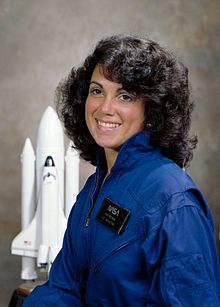Judith Resnik | |
|---|---|
 Official portrait, 1978 | |
| Born | Judith Arlene Resnik April 5, 1949 Akron, Ohio, U.S. |
| Died | January 28, 1986 (aged 36) North Atlantic Ocean |
| Resting place | Arlington National Cemetery |
| Education | Carnegie Mellon University (BS) University of Maryland, College Park (MS, PhD) |
| Awards | |
| Space career | |
| NASA astronaut | |
Time in space | 6d 0h 56m |
| Selection | NASA Group 8 (1978) |
| Missions | STS-41-D STS-51-L (Space Shuttle Challenger disaster) |
Mission insignia |  |
| Scientific career | |
| Thesis | Bleaching Kinetics of Visual Pigments (1977) |
| Doctoral advisor | Felix Zajac |
Judith Arlene Resnik (April 5, 1949 – January 28, 1986) was an American electrical engineer, software engineer, biomedical engineer, pilot and NASA astronaut who died in the Space Shuttle Challenger disaster. She was the fourth woman, the second American woman and the first Jewish woman of any nationality to fly in space, logging 145 hours in orbit.
Recognized while still a child for her intellectual brilliance, Resnik was accepted at Carnegie Institute of Technology after becoming only the sixteenth woman in the history of the United States to have attained a perfect score on the SAT exam. She graduated with a degree in electrical engineering from Carnegie Mellon before attaining a PhD in electrical engineering from the University of Maryland.
Resnik worked for RCA as an engineer on Navy missile and radar projects, as a senior systems engineer for Xerox Corporation, and published research on special-purpose integrated circuitry. She was also a pilot and made research contributions to biomedical engineering as a research fellow at the National Institutes of Health.
At age 28, Resnik was selected by NASA as a mission specialist. She was part of NASA Astronaut Group 8, the first group to include women. While training on the astronaut program, she developed software and operating procedures for NASA missions. Her first space flight was the STS-41-D mission in August and September 1984, the twelfth Space Shuttle flight, and the maiden voyage of Space Shuttle Discovery, where her duties included operating its robotic arm. Her second Shuttle mission was STS-51-L in January 1986 aboard Space Shuttle Challenger. She died when the orbiter broke up shortly after liftoff and crashed into the ocean.